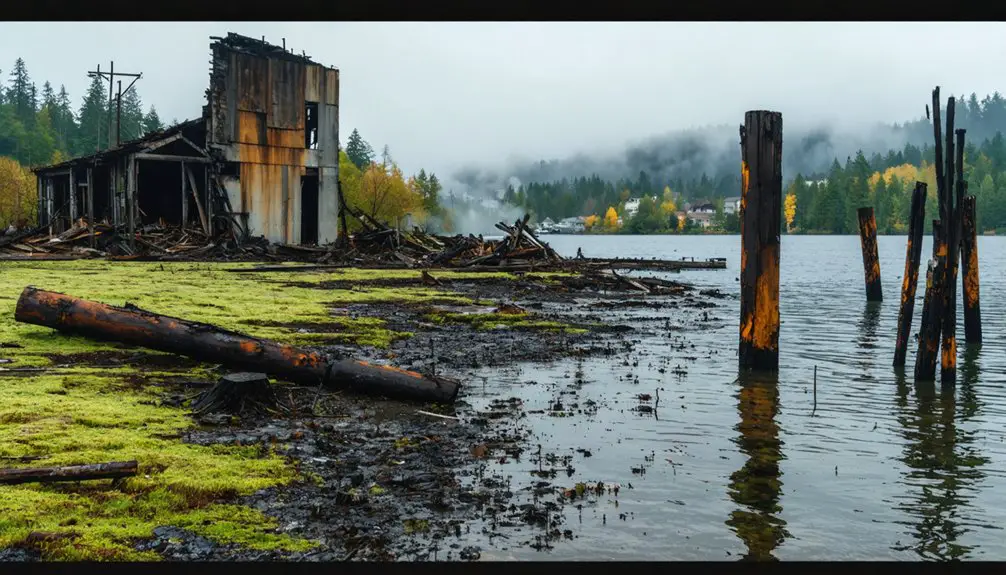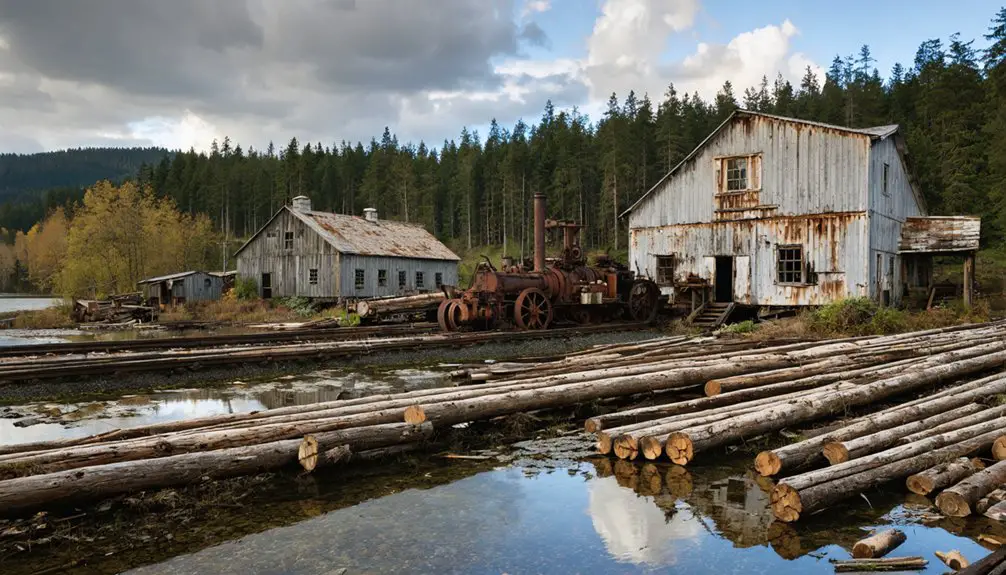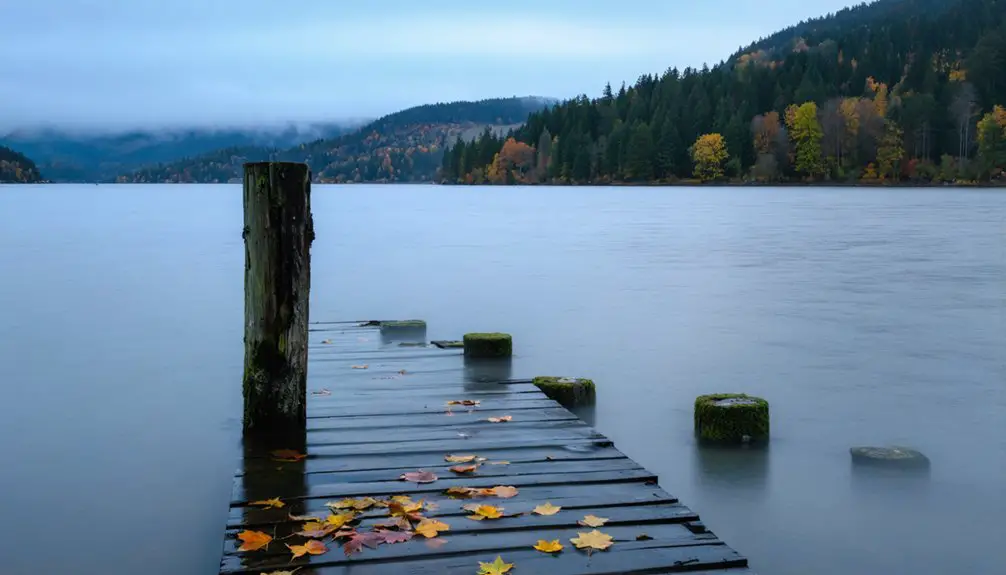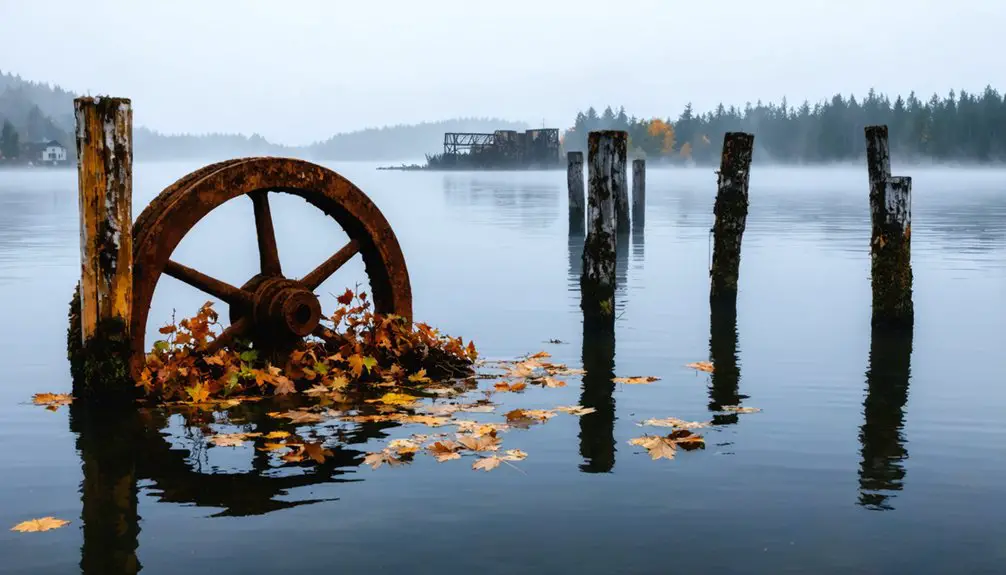You’ll find Monohon’s ghost town remnants along Lake Sammamish’s eastern shore, where Martin Monohon first homesteaded 160 acres in 1877. The lumber mill town flourished with 300 residents until June 26, 1925, when a discarded cigarette sparked a devastating fire during 98-degree heat, destroying 90% of structures. Recovery efforts were later hampered by the Great Depression, and today only submerged artifacts and the historic Monohon Hill Road preserve this once-bustling community’s untold stories.
Key Takeaways
- Monohon became a ghost town after a devastating fire in 1925 destroyed 90% of the town’s buildings and 300 residences.
- Located on Lake Sammamish’s eastern shore, Monohon was a thriving lumber town established in 1877 by pioneer Martin Monohon.
- The Allen & Nelson Mill Company was the town’s economic backbone until the fire, employing most of Monohon’s 300 residents.
- Recovery efforts after the 1925 fire were hampered by the Great Depression, leading to permanent decline and abandonment.
- Remnants of the once-prosperous mill town now lie submerged, preserving archaeological evidence of early Washington state settlement history.
The Pioneer Who Started It All: Martin Monohon
Pioneer spirit and determination brought Martin Monohon to Washington Territory in 1877, where he homesteaded 160 acres on Squak Lake’s eastern shore.
You’ll find his remarkable Monohon history began in Ohio, where he was born in 1820, before pushing westward through Indiana and Iowa, finally settling near present-day SE 24th Way and E Lake Sammamish Parkway.
His pioneer achievements extended beyond farming and raising livestock. Despite his lack of formal education, he taught himself literacy in his thirties to better understand Civil War writings. As an established merchant who’d already accumulated wealth, Monohon became a cornerstone of local development. Like pioneer Jacob Furth, he became a successful merchant through determination and business acumen.
Beyond tilling soil and tending herds, Monohon’s wealth and merchant experience made him vital to the region’s growth.
He built a log house that served as his home until 1906 and actively shaped Republican politics in King County.
You can trace his influence through the town that bore his name, the essential ferry landing he established, and his role in Washington’s shift to statehood in 1889.
Early Settlement and Community Formation
You’ll find the origins of Monohon in 1877, when Martin Monohon claimed his 160-acre homestead near present-day Sammamish Parkway and SE 24th Way.
The area initially fell under the broader “Donnelly” settlement during the 1870s-1880s, anchored by a sawmill on Squak Lake’s southwest shore established by Simon Donnelly and Mr. McMahone. The arrival of the Seattle Lake Shore railroad in 1887 facilitated the settlement’s growth and development.
By 1911, the settlement had grown into a bustling town with three hundred residents.
Pioneer Roots Begin Here
Along the eastern shore of what was then called Squak Lake, Martin Monohon established a pivotal 160-acre homestead in 1877 that would lay the foundation for a thriving community.
You’ll find his original log house near today’s SE 24th Way and E Lake Sammamish Parkway, where he faced pioneer challenges while raising livestock and engaging in local governance until 1906.
The area’s transformation began when Simon Donnelly’s sawmill sparked initial settlement in the 1870s. Like other pioneers, they transported logs by water to the mill for processing.
You can trace the community’s evolution from its first post office in 1885 under the name Donnelly, to its 1888 rebranding as Monohon.
Timber Town Takes Shape
The timber industry shaped Monohon’s early identity, beginning with Simon Donnelly’s sawmill on Squak Lake’s southwest shore in the early 1880s.
You’ll find the town’s timber economy truly took off when the Allen and Nelson Mill Company launched in 1889 with $50,000 in capital, transforming the area into a bustling lumber hub.
As the railroad arrived along the eastern shore, Monohon’s community dynamics flourished.
By 1911, you’d have found yourself among 300 residents in this charming mill town, where Martin Monohon’s 160-acre homestead and ferry landing had laid the groundwork for settlement.
The mill’s success brought prosperity, with lumber shipments reaching Minnesota, Alaska, and the Yukon.
Despite economic slumps in the mid-1890s, the town’s spirit and production remained resilient through the decade’s end.
Rise of the Lumber Industry
Following completion of the Lake Shore and Eastern Railroad track in 1889, Monohon’s lumber industry took root with the strategic relocation of Donnelly Mill to the eastern shore of Lake Sammamish. Massive old-growth trees, with some specimens reaching ages near 1,000 years, dominated the surrounding forests.
Allen & Nelson Mill Company invested $50,000 to establish operations that would anchor the town’s economy for 36 years. You’ll find that lumber expansion stretched far beyond local markets by 1900, reaching Minnesota, Alaska, and the Yukon territories. The innovative practice of storing logs in Lake Sammamish for washing became a standard procedure for local mills.
- Mechanized logging transformed operations when steam donkeys replaced animal power in the late 1890s.
- The mill’s 16-mile private rail network enabled deep forest access and efficient transport.
- New machinery in 1906 included gagger, lumber piler, and sawyer equipment under Bratnober ownership.
This industrial evolution positioned Monohon as a significant player in the Pacific Northwest’s timber trade.
Daily Life in a Thriving Mill Town
If you’d visited Monohon in its heyday, you’d have found its 300 residents living in a close-knit community centered around the Allen & Nelson Mill Company’s demanding work schedule.
Mill workers coordinated their daily routines with rail shipments, operating saws and processing timber that would be sent to markets as far as Alaska and Minnesota. The workers’ day would begin when the morning whistle signaled the start of their shift at 7:30 AM.
After long workdays, the community gathered at local spots like the train station’s garden and gazebo, where the distinctive ying-yang emblem marked a place of social connection for mill families.
Mill Workers’ Daily Routines
While life in Monohon revolved around the mill’s demanding schedule, workers adapted to a precise daily rhythm marked by the mill whistle’s familiar blasts.
You’d hear the 7:30 AM whistle echo across the lake, signaling the start of work routines filled with physical labor and specialized tasks. Mill signals guided your day, from the noon lunch break to the late afternoon departure. Like enslaved workers who were subject to strict schedules, laborers had to maintain precise timekeeping to avoid punishment. Similar to enslaved cooks who began their day at four in morning, mill workers rose before dawn to prepare for their shifts.
- Sawyers, blacksmiths, and carpenters performed their duties amid sawdust and machinery noise.
- Workers walked to and from modest homes along East Lake Sammamish Road.
- Your time outside work centered on rest and preparation for the next grueling shift.
The tight-knit community structured their lives around these predictable patterns, with families planning meals and daily activities according to the mill’s steady rhythm.
Community Social Activities
Despite the demanding mill schedules, Monohon’s 300 residents enjoyed a vibrant social life centered around Lake Sammamish’s shores and the bustling railroad station.
You’d find townspeople gathering for community celebrations marking social milestones like mill openings and successful log shipments, with the mill whistle coordinating these festivities.
In your free time, you could join neighbors for fishing trips on the lake or challenge friends to impromptu baseball games in open spaces.
The railroad station’s garden offered a peaceful spot to relax, while evening dances and music sessions brought workers’ families together after long shifts.
The post office and small shops served as natural meeting points where you’d catch up on local news and strengthen bonds with fellow residents.
The Devastating Fire of 1925

On June 26, 1925, a carelessly discarded cigarette in the sawmill’s washroom ignited a devastating fire that would forever change Monohon, Washington. The previous day’s record-breaking heat of 98 degrees, combined with unusually dry conditions, created the perfect storm for this disaster.
As stiff north winds fanned the flames, you would’ve witnessed the fire’s unstoppable advance through the town, demonstrating the crucial importance of fire prevention in mill communities.
- The blaze destroyed 90% of the town’s 300 residences
- All major structures, including the essential J.E. Bratnober sawmill, were reduced to ashes
- The entire business district was obliterated within hours
The fire’s rapid spread forced Monohon’s 300 residents to flee, primarily along East Lake Sammamish Road, marking a turning point in community resilience as the once-thriving mill town became a ghost town.
Rebuilding and Depression Era Struggles
After the devastating 1925 fire, Monohon’s path to recovery became increasingly arduous as the Great Depression gripped the nation in 1929. You’d find the once-bustling mill town facing unprecedented economic challenges, with operations completely halted for three and a half years in the early 1930s.
Despite 25% unemployment across King County, Monohon’s community resilience shone through. The town’s 60 homes and roughly 300 residents maintained their social bonds through organizations like the Norwegian Club.
You’d see neighbors supporting each other while government relief arrived through New Deal programs and the Union Coal League’s commissaries. Even during the darkest days, including the 1937 recession and relief cutbacks, townspeople adapted – some even turning to moonshine production, as evidenced by a 50-gallon discovery during a 1925 raid.
Final Years of the Mill Operations

While the Allen and Nelson Mill Company had anchored Monohon’s economy for 36 years since 1889, the 1920s marked a steep decline in the mill’s fortunes.
You’ll find that several factors contributed to the mill’s downfall: depleted timber availability around Lake Sammamish by 1930, reduced national demand after World War I, and the eastward shift of logging operations to the Plateau region.
- Timber reserves were exhausted by the 1940s, severely impacting mill productivity.
- The mill’s product focus shifted from Douglas fir to Western red cedar for shingle production.
- Despite Bratnober’s attempt to rebuild the mill in 2006, operations ceased within a couple of years.
Even with railroad spurs, steam donkeys, and logging trucks modernizing operations, the mill couldn’t overcome the fundamental challenges of diminishing timber supply and changing market dynamics.
What Remains Today
Today’s visitors to Monohon won’t find the bustling mill town that once stood here – instead, the remnants lie mostly beneath the waters of Rattlesnake Lake. During low water levels, you’ll spot stone foundations and fireplace remnants emerging from the depths, offering glimpses into the town’s past.
As you walk the paved trails that follow old town pathways, you might notice fallen debris and scattered structural remains blending into the natural environment.
The site holds significant archaeological potential, with submerged remnants preserved by the lake waters since 1915. While there’s limited interpretive signage focusing on the town’s history, you can still sense the original settlement’s scale by circling the lakeshore.
The best viewing occurs in late summer and fall when receding waters reveal more of Monohon’s hidden features.
Legacy of a Lost Lake Sammamish Community

The story of Monohon begins with Martin Monohon’s 1877 homestead claim of 160 acres along the eastern shore of what was then called Squak Lake.
You’ll find the community’s historical significance deeply woven into Lake Sammamish’s development, from the essential lumber production that helped rebuild Seattle after its Great Fire to the establishment of important transportation routes.
The community legacy of this pioneering settlement lives on through:
- The Northern Pacific Railroad’s lasting impact on regional connectivity and commerce
- Monohon Hill Road, which Martin Monohon built in 1887, still serving as a significant route to the Sammamish Plateau
- The town’s contribution to Seattle’s post-fire reconstruction, highlighting its role in shaping the region’s early development
Despite its tragic end in 1925, Monohon’s influence on the area’s growth remains undeniable.
Frequently Asked Questions
What Was the Average Wage of a Lumber Mill Worker in Monohon?
You’d have earned around $1.05 to $1.45 per hour in the lumber industry at Monohon’s mills, with wages reflecting the economic impact of your specific role and skill level.
Were There Any Schools or Churches Established in the Town?
You won’t find any schools or churches in Monohon’s history – it’s a surprising fact given how important these institutions were back then. The town’s small size and short lifespan prevented their establishment.
How Did Native Americans Interact With the Monohon Community?
You’ll find Native Americans maintained cultural exchanges through labor at local mills, established trade agreements for resources, and adapted traditional fishing practices while working alongside settlers around Lake Sammamish’s shoreline.
What Recreational Activities Did Residents Enjoy During the Town’s Peak?
You’d find yourself in a million magical moments at Lake View Hotel’s gatherings, exploring endless hiking trails, discovering prime fishing spots, enjoying communal meals, and bonding with neighbors at the bustling meeting hall.
Did Any Major Crimes or Notable Incidents Occur Before the 1925 Fire?
You won’t find documented major crime history or notable events before the 1925 fire, though mining towns typically faced incidents. Any pre-fire occurrences in Monohon remain unconfirmed by historical records.
References
- https://www.historylink.org/File/7780
- https://sammamishheritage.files.wordpress.com/2018/10/monohon.pdf
- https://www.historylink.org/File/8375
- https://www.youtube.com/watch?v=2Saj0oIS4tc
- https://en.wikipedia.org/wiki/List_of_ghost_towns_in_Washington
- https://ahgp.org/wa/washington-pioneer-dead-1914.html
- https://archiveswest.orbiscascade.org/ark:80444/xv24644?q=thomas+prosch
- https://kingcounty.gov/vi-vn/-/media/king-county/depts/dnrp/building-property/historic-preservation-program/papers-and-research/kingcountyhistoricsettlementcontext.pdf
- https://pauldorpat.com/seattle-now-then-archive/2009-01-11-lake-sammamish-monohon-with-three-os/
- https://www.issaquahhistorymuseums.com/post/squak-valley-s-journey-from-wilderness-to-homestead



